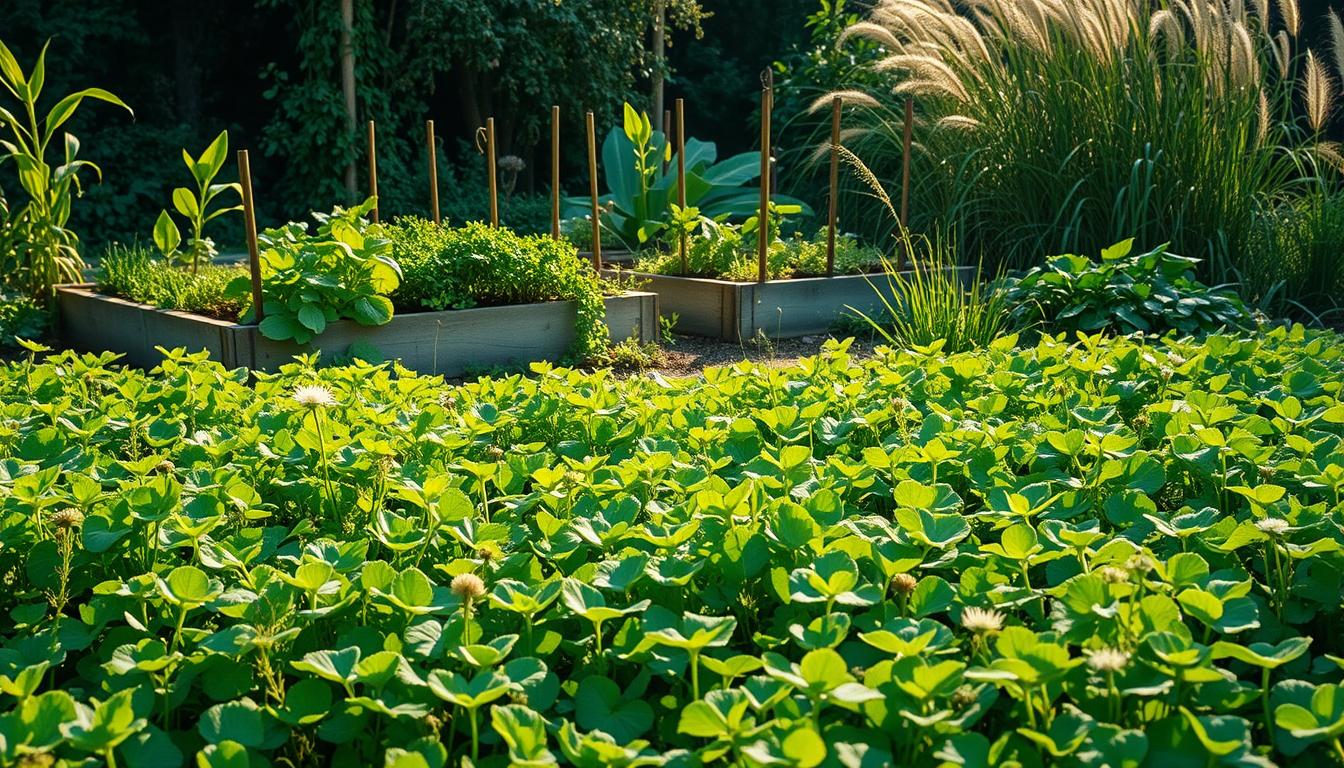Are you tired of fighting weeds with harsh chemicals? You’re not alone. More gardeners are choosing organic gardening instead. They want to avoid harming beneficial insects and keeping their soil clean.
Natural weed control is good for your wallet, health, and the planet. It saves money on chemicals and keeps you safe from harmful substances. Plus, it helps protect our environment by reducing synthetic chemicals.
These methods work for everyone, no matter the size of your garden. You can use items you already have to keep weeds away. Making a few simple changes can make a big difference in your garden’s health.
Want to learn how to work with nature instead of fighting it? Let’s find out the best ways to keep your garden weed-free and eco-friendly.
The Hidden Costs of Chemical Weed Control
Chemical weed control costs more than just the price tag. It affects our environment and health in ways we don’t see right away. Instead of quick fixes, gardeners are choosing natural methods that work with nature.
Environmental Impact of Herbicides
Herbicides don’t stay where they’re applied. Up to 95% of them end up in places they shouldn’t be, harming soil, water, and wildlife. This damage affects local ecosystems deeply.
Glyphosate, a common herbicide, stays in soil for up to six months. It messes with the soil’s balance, harming plants. It also gets into water systems, affecting fish and potentially our drinking water.
Herbicides are also bad for bees. Bee populations are already struggling, and herbicides make it worse. Even “bee-safe” herbicides can harm bees over time. This hurts the garden ecosystem, making it harder for gardeners to keep things healthy.
Health Risks for Gardeners and Families
Chemicals that kill weeds can harm humans too. Gardeners often get skin rashes, eye problems, and breathing issues. Even with safety gear, they can still get sick.
Children and pets are even more at risk. Kids can get sick from touching treated lawns, and dogs can get poisoned by licking their paws after walking on treated areas.
Long-term health risks are scary. Glyphosate might cause cancer and other serious health problems. Many gardeners now choose natural methods to avoid these dangers.
Understanding Weed Growth Patterns
Knowing how weeds grow is key to controlling them naturally. Weeds are not just pests; they are plants that have learned to outdo other plants. By understanding them, we can fight them without using harmful chemicals.
Weeds have survived for thousands of years by adapting to their environments. Identifying and understanding different weeds helps gardeners target their efforts. This leads to better results in the long run.
Why Weeds Thrive in Gardens
Gardens are perfect for weeds to grow. Tilling soil brings weed seeds to the surface, where they can grow. Weeds can produce thousands of seeds, lasting for decades in the soil.
Weeds grow faster than other plants, grabbing sunlight, water, and nutrients first. Their roots are also better at getting nutrients.
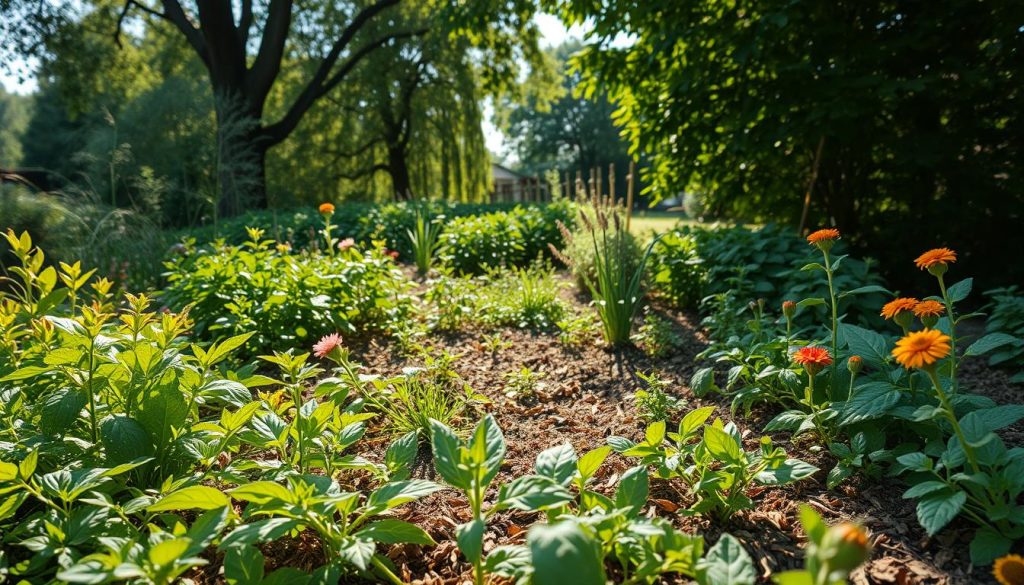
Weeds love disturbed areas, like gardens. They quickly grow on bare soil and use the water and fertilizer meant for other plants. Some weeds even stop other plants from growing by releasing chemicals.
Just pulling weeds isn’t enough. We need to use strategies that stop weeds from getting what they need to grow.
Identifying Common Garden Weeds
Starting with weed identification is crucial. Different weeds need different ways to be controlled. Knowing the common weeds helps you plan how to stop them.
Weeds are mainly annuals, perennials, or invasive species. Each type grows and spreads differently. Knowing this helps you fight weeds more effectively.
Annual Weeds
Annual weeds grow and die in one season. They spread mainly through seeds. For example, crabgrass can produce up to 150,000 seeds. To control them, focus on stopping seeds and using mulch and timely removal.
Perennial Weeds
Perennial weeds come back year after year from the same roots. They store energy in their roots, making them hard to kill. They spread through seeds and parts like rhizomes. To control them, cut them back repeatedly or remove the roots.
Invasive Species
Invasive weeds are non-native plants that take over. They spread fast because they don’t have natural enemies. They can change entire ecosystems. Controlling them often requires a team effort and many strategies.
The Benefits of Natural Weed Suppression
Using natural ways to control weeds is great for your garden and the planet. Unlike chemical weed killers, natural methods last longer and make your garden healthier. They work with nature, making your garden stronger and more sustainable.
Methods like mulching, cover cropping, and crop rotation are key to managing weeds. These strategies help control weeds while making your garden’s ecosystem better. Let’s look at the good things these natural methods bring.
Ecosystem Health and Biodiversity
Natural weed control keeps your garden’s ecosystem in balance. Chemical weed killers harm good bugs and soil life, which your garden needs to grow well.
Choosing natural methods protects your garden’s diversity. Good bugs like ladybugs and earthworms keep pests and soil healthy. This balance helps your garden fight off pests and diseases on its own.
Your garden becomes more stable and less likely to get sick. This means you don’t need to use as many chemicals to keep it healthy.
Soil Quality Improvement
Many natural weed control methods also make your soil better. Crop rotation stops weeds and keeps the soil rich. By changing what grows in your garden each season, you confuse weeds and help the soil.
Organic mulch adds nutrients to the soil as it breaks down. This makes your soil better at holding water and nutrients. Your plants grow stronger and can fight off weeds better.
Cover crops also help your soil. They break up hard soil and add nitrogen. This creates a cycle where better soil means healthier plants that resist weeds.
Cost-Effectiveness Over Time
Chemical weed control might seem easy at first, but natural methods save money in the long run. The cost of mulch or cover crop seeds pays off for many seasons. Natural methods protect your garden without the need for constant chemical use.
Natural gardening also saves money on other things. Healthy soil needs less fertilizer, and plants are less likely to get sick. This means you spend less on fungicides and replacing plants.
Thinking about the whole cost, natural weed control is the better choice. It saves you money and keeps you and the environment safe from chemicals.
| Benefit CategoryNatural Weed SuppressionChemical Weed ControlLong-term ImpactEcosystem HealthPreserves beneficial insects and soil lifeHarms pollinators and soil organismsGreater garden resilience with natural methodsSoil QualityImproves structure and adds nutrientsCan lead to soil degradationEnhanced plant health and natural fertilityCost Over TimeInitial investment with diminishing costsRecurring purchases and applicationsSignificant savings with natural approachesPlant HealthStronger plants with natural resistancePossible plant stress from chemicalsReduced need for interventions with natural methods |
|---|
Mulching: Nature’s Weed Barrier
Mulch acts as a natural shield against weeds, benefiting your garden in many ways. It blocks sunlight, stopping weed seeds from growing. Mulch also keeps soil moist, controls temperature, and adds nutrients as it breaks down.
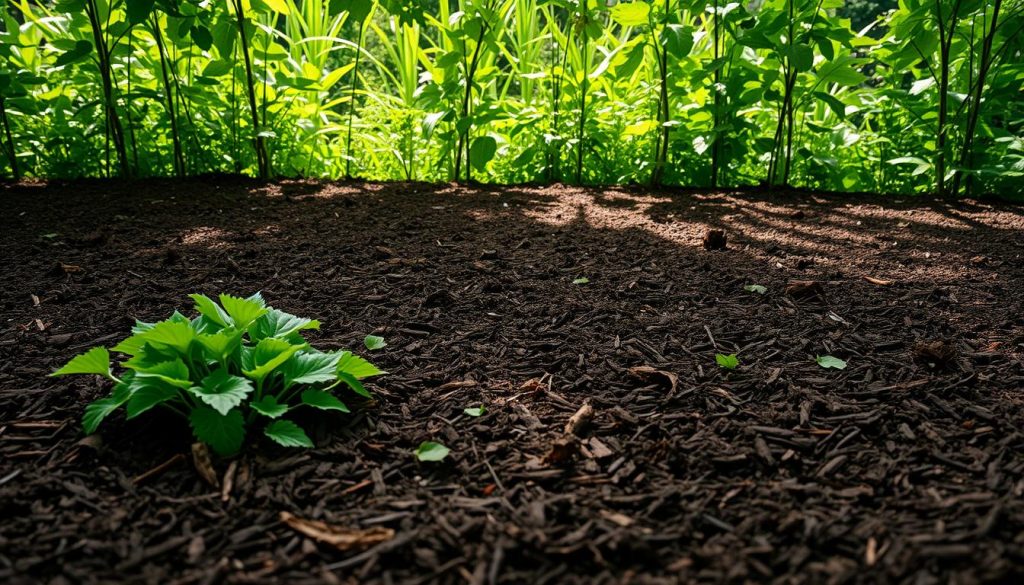
Mulching is a simple, green way to manage weeds. It creates a barrier that helps your plants grow better than weeds. Let’s look at different mulching options and methods to improve your garden.
Organic Mulch Options
Organic mulches fight weeds and improve soil as they decompose. They come in various types, each with its own look, lifespan, and nutrient value. You can pick the best one for your garden.
Straw and Hay
Straw is a cheap, good mulch for veggies. It’s light, easy to spread, and breaks down slowly. Hay, though, has more seeds, so choose seed-free or composted hay to avoid weeds. Both protect roots and add to the soil as they decompose.
Wood Chips and Bark
Wood mulches last longer, perfect for perennials and trees. Cedar and cypress chips keep bugs away, while pine bark keeps soil acidic for acid-loving plants. They decompose slowly, offering long-lasting weed control.
Compost and Leaf Mold
Compost and leaf mold are nutrient-rich mulches that feed your soil and block weeds. They’re great for veggies and annuals where soil health is key. They break down fast, giving plants nutrients and controlling weeds.
Inorganic Mulch Alternatives
Inorganic mulches are durable for long-term weed control. Landscape fabric lets water and air in while keeping weeds out. It’s good under stone or in paths. Rubber mulch, from recycled tires, lasts long but doesn’t improve soil.
Decorative stones and gravel make permanent, weed-free barriers. They’re perfect for drought-tolerant areas and around foundations. They don’t improve soil but need little upkeep and save weeding time.
Proper Mulching Techniques
Good mulching starts with the right application. Remove weeds first and use enough mulch to block light – 2-4 inches for organics, 1-2 inches for denser ones. Pull mulch back from plants to avoid rot and pests.
Timing is key. Mulch in early spring after the soil warms up. Refresh organic mulch yearly or as it breaks down. For veggies, pull back mulch in spring to warm the soil, then reapply when plants grow.
Cover Crops as Weed Suppressors
Cover crops are a smart way to fight weeds and improve soil health. They fill in bare spots where weeds might grow, outcompeting them. Unlike chemicals, cover crops work with nature, offering many benefits.
By growing densely, cover crops block sunlight, stopping weed seeds from germinating. Their roots also break up hard soil, making it hard for weeds to grow. This natural method keeps your garden healthy and weed-free.
Best Cover Crop Species for Weed Control
Choosing the right cover crop is key to controlling weeds. Look for fast-growing, dense plants that also stop weeds from growing. Different seasons need different cover crops.
Winter cover crops protect your soil when it’s cold. Cereal rye is great for winter, making compounds that stop weeds. Hairy vetch and winter wheat also keep weeds away while improving soil.
Summer Cover Crops
Summer cover crops grow fast to fill gaps between crops. Buckwheat flowers quickly, shading out weeds. Cowpeas and sorghum-sudangrass handle heat well, controlling weeds and attracting beneficial insects.
Fast-Growing Varieties
For quick weed control, some cover crops are better than others. Mustard and phacelia grow fast, blocking light from weeds. Annual ryegrass is quick to establish, perfect for emergency weed control.
Seasonal Planting Strategies
Planting cover crops at the right time boosts their effectiveness. In the north, plant winter crops in late summer or early fall. In the south, plant them late fall or early winter.
For summer crops, wait until soil is warm. Plan your planting to avoid gaps. Even short periods can be used with fast-growing crops like buckwheat or mustard. This keeps your garden weed-free all year.
Managing Cover Crop Transitions
Switching from cover crops to food crops needs careful timing. Terminate winter crops 2-3 weeks before planting spring crops. This lets them partially break down while keeping the soil weed-free.
There are several ways to end cover crops. Mowing or cutting at soil level works for many. For small areas, turning the crop into the soil is effective. Some use the “crimp and roll” method, laying the crop flat for mulch.
| Cover Crop Type | Best Planting Season | Weed Suppression Rating | Additional Benefits | Termination Method |
|---|---|---|---|---|
| Cereal Rye | Fall | Excellent | Erosion control, allelopathic effects | Mow/crimp at flowering |
| Buckwheat | Summer | Good | Pollinator attraction, phosphorus scavenging | Mow before seed set |
| Hairy Vetch | Fall | Very Good | Nitrogen fixation, soil building | Mow/crimp at flowering |
| Mustard | Spring/Fall | Good | Biofumigation, rapid establishment | Till under before flowering |
| Sorghum-Sudangrass | Summer | Excellent | Deep soil penetration, biomass production | Mow multiple times or frost-kill |
Companion Planting for Weed Management
Companion planting is a smart way to fight weeds. It uses plants to naturally keep weeds away. By choosing the right plants to grow together, your garden will look great and fight weeds.
Plant Combinations That Discourage Weeds
Some plants are better at fighting weeds than others. Tall plants like tomatoes and sunflowers block sunlight, stopping weeds from growing. Herbs like thyme and mint spread out and smother weeds.
Marigolds are special because they release chemicals that stop weeds. They’re great for keeping nematodes and weeds away.
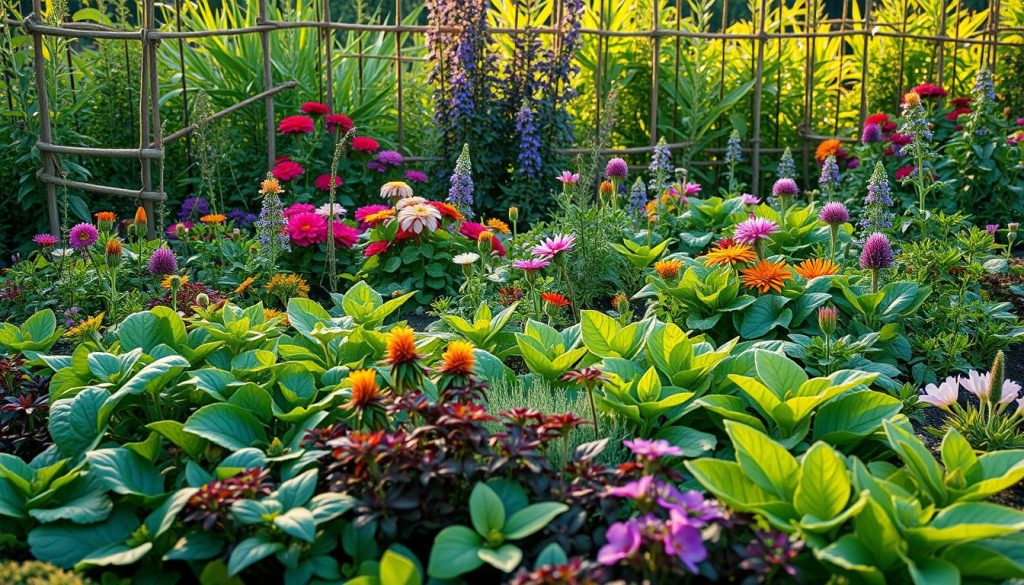
For veggies, try basil with tomatoes or nasturtiums with cucumbers. In flower beds, mix tall plants with low-growing ones like sweet alyssum. Alyssum attracts insects that fight pests.
Spacing and Garden Design Considerations
Good garden design is key to fighting weeds. Plan your garden so plants help each other and block weeds. This way, your garden will be beautiful and weed-free.
Plant in patterns that cover the ground well. Staggered or triangular patterns are better than straight rows. This makes your garden look natural and fights weeds.
Dense Planting Techniques
Dense planting means planting close together. This creates a canopy that shades the soil, stopping weeds. For example, plant lettuce 6 inches apart instead of 10.
Make sure the soil is rich and moist for dense planting. It might cost more at first, but you’ll save time and effort later.
Vertical Gardening Benefits
Vertical gardening uses space to fight weeds. Plants like cucumbers and peas grow up, shading the ground. This makes your garden more efficient and weed-free.
Under climbing plants, you can grow shade-tolerant plants like spinach. This makes the most of your space and looks good too.
Implementing Natural Weed Suppression in Your Garden
To control weeds naturally, you need a good plan and consistent effort. Using mulch or companion planting helps, but combining them works best. Let’s look at how to make a weed management system that works with nature.
Creating a Comprehensive Management Plan
First, understand your garden’s ecosystem. Walk your garden and see where weeds are a problem. Know the weeds you’re fighting, as each one needs a different solution.
Then, think about what you can do. Consider your time, budget, and what materials you have. A plan that fits your life is more likely to succeed. Natural weed control is a long-term effort.
Map out your garden and plan improvements. Different areas need different weed control methods. Divide your garden into zones based on weed pressure and plant types. Then, choose the right suppression methods for each zone.
Adding crop rotation to your vegetable garden is also smart. It breaks weed cycles, improves soil, and fights pests. A four-year rotation can cut down weed pressure over time.
Seasonal Weed Control Calendar
Timing is key in weed management. Different seasons need different weed control strategies. A seasonal calendar helps you attack weeds when they’re weakest.
| Season | Primary Tasks | Preventive Measures | Maintenance Activities |
|---|---|---|---|
| Spring | Remove overwintered weeds before seeding | Apply fresh mulch layers | Plant dense cover crops in empty beds |
| Summer | Regular shallow hoeing in morning hours | Maintain 2-3 inch mulch depth | Use companion planting in new plantings |
| Fall | Remove seed-bearing weeds completely | Plant fall cover crops | Add compost to improve soil structure |
| Winter | Plan next year’s crop rotation | Use sheet mulching for problem areas | Maintain winter-hardy cover crops |
Combining Multiple Techniques for Best Results
The best weed control systems use many techniques together. For example, mulch between vegetables and cover crops blocks weeds.
Start with healthy soil through organic matter. This helps beneficial organisms fight weeds. Then, use mulch to block weed seeds from sunlight.
Use living barriers by planting densely. This leaves little room for weeds. Add seasonal crop rotation for a weed-resistant garden without chemicals.
Don’t try to do everything at once. Start with a few techniques and add more as you get better. Even small steps help your garden’s health and productivity.
Physical Weed Control Methods
Learning a few hands-on weed control techniques can greatly improve your garden. Mulching and companion planting help, but sometimes you need to get your hands dirty. Physical methods give quick results and can be very rewarding.
Proper Hoeing Techniques
Hoeing is all about timing and technique, not just strength. The best time is on a sunny, dry day. This way, weeds dry out fast after being cut.
Try to cut weeds just below the soil surface, about 1-2 inches deep. This stops dormant weed seeds from growing. Keep your hoe blade sharp for clean cuts and use a shallow, scraping motion.
When hoeing around plants, pull the hoe toward you. This avoids damaging the roots of good plants. This method is called a draw-cut.
- Hoe when soil is slightly dry but not compacted
- Use a shallow angle to slice rather than dig
- Work backward to avoid stepping on freshly hoed areas
- Maintain a regular hoeing schedule to catch weeds when small
Strategic Hand Pulling
Hand pulling is great for getting rid of weeds with deep roots. Make sure to pull the whole plant, including roots, to stop it from coming back. Wait until the soil is moist but not muddy for easier pulling.
Grasp weeds firmly at the base and pull straight up. For tough taproots, use a slight rocking motion. Work in sections and focus on weeds that are flowering to prevent them from spreading seeds.
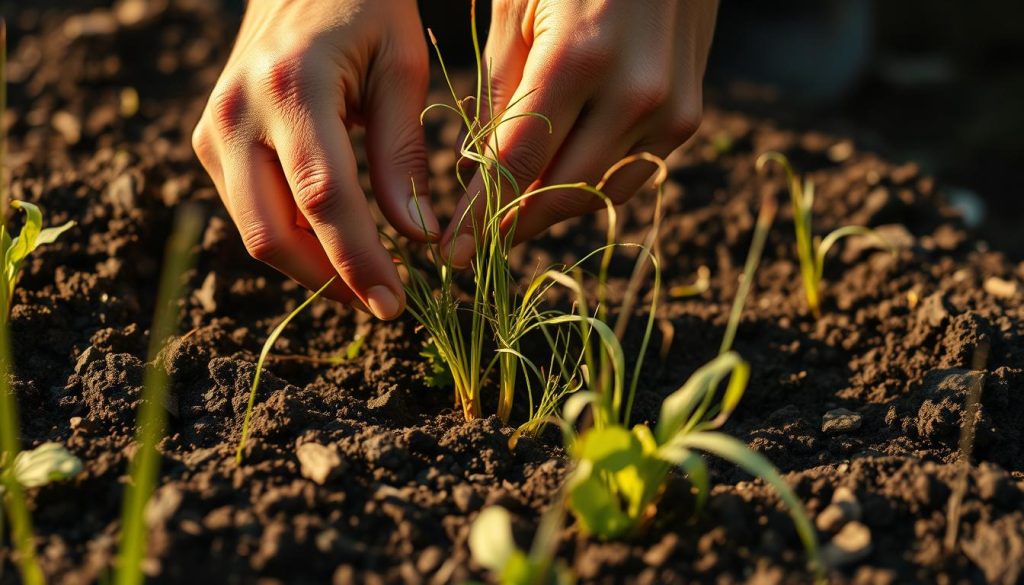
Tools That Make Weeding Easier
The right tools can make weeding easier and less tiring. Modern tools are designed to reduce strain and increase efficiency. Investing in good tools will make your garden healthier and more comfortable to work in.
Hand Tools
Hand tools are perfect for weeding in tight spaces. The Japanese hori hori knife is great for slicing and digging weeds. Cape cod weeders are good for working between pavers. Forked dandelion diggers are perfect for lawns and established beds.
Long-Handled Tools
Stand-up weeders save your back and knees. Stirrup hoes are efficient for cutting weeds on both push and pull strokes. Collinear hoes are great for precision work. Dutch hoes are good for large areas.
Modern Weeding Innovations
New weeding technology combines old methods with new ones. Thermal weeders use heat to kill weeds without chemicals. Battery-powered cultivators are quiet and light, making weeding easier.
Regular weeding makes it easier and more effective. Small weeds are easier to remove than big ones. By using these techniques, weeding can become a rewarding part of gardening.
Advanced Natural Weed Suppression Techniques
There’s more to weed control than just mulching and pulling. Advanced methods can tackle tough weeds without harsh chemicals. These techniques are perfect for when simple methods fail.
Soil Solarization Methods
Soil solarization uses the sun to kill weeds. It works best in the summer when it’s hottest.
To start, clear the area of plants and debris. Water the soil well, then cover it with clear plastic sheeting. Use rocks or soil to keep the edges in place.
Leave the plastic on for 4-6 weeks in the summer. The heat will kill weed seeds and pests. It’s great for new beds or areas with lots of weeds.
Homemade Organic Herbicides
Homemade herbicides are good for young weeds. They’re not as strong on deep-rooted weeds.
A simple mix is 1 gallon of white vinegar, 1 cup of salt, and 1 tablespoon of dish soap. The vinegar and salt dry out the weeds, and the soap helps it stick. For stronger weed control, use horticultural vinegar but be careful.
Other options include boiling water and corn gluten meal. These methods kill the weed tops but might need to be done again. They’re good for preventing weeds from growing.
Flame Weeding and Other Alternatives
Flame weeding uses a propane torch to kill weeds. It works by heating the weeds to damage their cells. It’s not about burning them to ash.
Be careful with flame weeding. Don’t do it when it’s dry or near flammable things. Always have water nearby and check local fire rules.
Other methods include hot water and steam weeding. Commercial systems can kill weeds in hard surfaces. For small areas, boiling water works well without special equipment.
| Technique | Best For | Effectiveness | Time Required | Cost |
|---|---|---|---|---|
| Soil Solarization | New beds, severe infestations | High (kills seeds and pathogens) | 4-6 weeks | Low (plastic sheeting) |
| Vinegar Solution | Young annual weeds | Moderate (requires reapplication) | Hours to days | Low (household ingredients) |
| Corn Gluten Meal | Preventing seed germination | Moderate (pre-emergent only) | Seasonal application | Medium |
| Flame Weeding | Pathways, hard surfaces | High for small weeds | Immediate results | Medium-high (equipment) |
| Boiling Water | Cracks in pavement, spot treatment | Moderate (top growth only) | Immediate results | Very low |
Embracing a Weed-Resistant Garden Philosophy
Natural weed suppression is more than just techniques. It’s a new way of thinking about our gardens. When we create balanced ecosystems, weeds find it tough to grow.
A weed-resistant garden starts with healthy soil. Soil that’s rich and alive helps plants grow strong. This way, you spend less time fighting weeds and more time enjoying your garden.
Observation is key in this approach. Knowing your garden’s patterns helps you choose the right plants and where to put them. This makes your garden healthier and more weed-free.
Don’t aim for a perfect garden. Even the most stunning gardens have weeds. Some wild plants help by attracting pollinators or improving soil.
Working with your garden’s natural tendencies makes weed suppression easier. Planting densely, using mulch, and designing thoughtfully all help. These methods make it hard for weeds to grow.
Creating a weed-resistant garden is a gradual process. Each season teaches you more and helps you improve. As you use the methods from this guide, you’ll understand your garden better.
This holistic philosophy leads to a beautiful and resilient garden. It rewards your hard work with growth and less upkeep.

